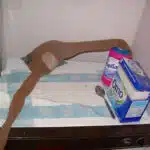As a laundry care expert, it is crucial to educate others on the various methods of drying clothes. Line drying laundry indoors is an efficient and cost-effective way of accomplishing this task. Not only does it save energy and reduce environmental impact, but it can also preserve the quality of clothing materials.
There are several factors to consider when line drying laundry indoors, such as humidity levels, air circulation, and choice of location. By utilizing proper techniques and following a few simple steps, individuals can master the art of indoor line drying and reap its many benefits. This article will provide a comprehensive guide on how to line dry laundry indoors effectively while ensuring that clothes are fresh, clean, and perfectly dry.
Benefits Of Line Drying Indoors
Line drying laundry indoors can offer several benefits over using a dryer. Not only does it save energy and reduce your carbon footprint, but it can also help preserve the quality of your clothing. In addition, by line drying indoors, you can avoid exposing your clothes to outdoor pollutants and allergens.
To make the most of indoor line drying, there are a few tips to keep in mind. Firstly, finding the right spot is essential. Look for an area with good air circulation and enough space to accommodate your laundry. Consider using a clothesline or drying rack that can be easily adjusted to fit different items of clothing.
Another important factor is humidity levels. Understanding the humidity in your home can help you choose the best time for line drying and prevent excess moisture from causing mildew or mold growth on your clothes. By keeping tabs on these levels and adjusting accordingly, you can ensure that your laundry dries quickly and efficiently without any damage.
As with any form of laundry care, taking the time to properly line dry your clothes can pay off in the long run. By following these tips for efficient indoor line drying, you’ll not only save energy but also extend the lifespan of your garments while keeping them fresh and clean. Now let’s move on to understanding humidity levels – an important aspect of successful indoor line drying.
Understanding Humidity Levels
Humidity control is essential when line drying laundry indoors. High humidity levels will slow down the drying process and may leave your clothes feeling damp. It’s important to have proper moisture management in place to avoid any mold or mildew growth on your clothes. The optimal humidity level for laundry drying is between 30% and 50%.
To achieve the ideal humidity level, you can use a dehumidifier or air conditioning unit to remove excess moisture from the air. Another option is to open windows and doors to allow proper ventilation and airflow. If you live in an area with high humidity levels, you may want to consider using a portable air conditioner or a standalone dehumidifier specifically designed for laundry rooms.
Humidity control is not only necessary for efficient laundry drying, but it also plays a vital role in maintaining indoor air quality. High humidity levels can cause health problems such as allergies and respiratory issues. By managing the moisture content in your home, you’ll create a healthier living environment for you and your family.
As we’ve discussed, achieving the right humidity level is crucial when line drying laundry indoors. In the next section, we’ll explore how choosing the right location can further optimize your drying process.
Choosing The Right Location
When it comes to line drying your laundry indoors, choosing the right location is crucial. The ideal spot should have adequate lighting options and enough space to hang your clothes without them touching each other. It’s important to avoid any areas that may be humid or damp, such as a basement or bathroom, as this can lead to mold and mildew growth on your clothes.
One of the best places for indoor line drying is near a large window with plenty of natural light. This not only helps your clothes dry faster but also prevents them from developing any musty odors. If you don’t have access to a window, consider setting up a drying rack under a ceiling light or using a portable lamp to provide ample illumination.
Additionally, make sure you have enough space for your clothes to hang freely without overlapping. A common mistake people make is overcrowding their drying area, which can lead to longer drying times and wrinkled clothes. If you’re short on space, consider using collapsible drying racks or installing a tension rod in a narrow hallway or closet.
In summary, choosing the right location for indoor line drying requires considering both lighting options and space requirements. Aim for an area with plenty of natural light or artificial illumination and enough room for your clothes to hang freely without touching each other. By taking these factors into account, you’ll create an optimal environment for efficiently and effectively air-drying your laundry indoors.
Transition: Now that you’ve found the perfect location for indoor line drying, it’s time to prepare your clothes properly before hanging them up.
Preparing Clothes For Indoor Line Drying
After choosing the right location for indoor line drying, it is important to sort clothes according to their fabric type. This will help prevent damage and ensure that each garment dries evenly. Delicate fabrics such as silk, wool, and lace should be hung separately from heavier items like jeans and towels. Be sure to read the care label on each garment before washing and drying.
When preparing clothes for indoor line drying, it is important to take extra care with delicate fabrics. These fabrics should be washed in cold water with a gentle detergent and then hung carefully to dry. Never wring out delicate fabrics as this can cause damage or stretching. Instead, gently squeeze out any excess water before hanging.
Drying delicate fabrics indoors can be a challenge but there are some tips and tricks that can help make the process easier. One tip is to use a mesh laundry bag for delicates. This will help protect them from snagging or tangling while they dry. Another tip is to hang delicate items on a padded hanger to prevent creasing or damage to the fabric. By taking these precautions, you can ensure that your delicate garments are dried safely and without any damage.
Transition: Now that we have covered how to prepare clothes for indoor line drying, let’s move on to some helpful tips for hanging clothes in order to maximize space and efficiency.
Tips For Hanging Clothes
To ensure that your clothes dry evenly and without damage, it is important to hang them properly. There are various types of hangers available that can be used based on the fabric and weight of the clothing. For instance, padded hangers are suitable for delicate fabrics, while wooden or plastic hangers are ideal for heavier items.
When hanging clothes, it is also important to consider creative arrangements that maximize space usage and prevent overcrowding. One method is to use a tiered hanger system where multiple items can be hung vertically on one hook. Another option is to use a door-mounted hanging rack or an over-the-door hanger that utilizes unused space behind doors.
To further protect your clothes from stretching or misshaping while drying indoors, avoid using wire hangers or clips as they can leave marks on the fabric. Opt for non-slip hangers or those with padded clips instead. Additionally, remember to leave enough space between each item when hanging them to promote proper air circulation and prevent dampness.
Next, let’s explore some tips on maximizing air circulation to speed up the drying process and ensure fresh-smelling laundry.
Maximizing Air Circulation
The use of fans can be an effective way to increase air circulation when drying laundry indoors. Opening windows can also help to create a cross breeze and increase air flow. Ventilation systems should also be considered when looking to optimize air circulation in a laundry space. Installing a ducted ventilation system with both supply and exhaust air capabilities is an efficient approach to improving air circulation within a laundry space.
Using Fans
To maximize air circulation when line drying laundry indoors, using fans is an effective strategy. Fans help to distribute air throughout the room, ensuring that all clothes are dried evenly. However, it is important to choose the right fan for your space and needs.
One consideration when choosing a fan is the size of your indoor drying area. A small room may only require a table or floor fan, while a larger area may need a ceiling or wall-mounted fan. Additionally, consider the direction of airflow and choose a fan that can be adjusted to blow air in different directions. This will allow you to direct the airflow towards wet clothes and ensure they dry faster.
Another factor to consider when using fans for indoor line drying is humidity levels. High humidity can slow down drying times and make it more difficult to fully dry clothes indoors. To combat this issue, consider investing in a dehumidifier. These appliances remove moisture from the air, creating a drier environment that speeds up drying times and reduces the risk of mold or mildew growth on damp clothing.
In conclusion, using fans can be an effective method for maximizing air circulation when line drying laundry indoors. By choosing the right fan and considering humidity levels with a dehumidifier, you can create an optimal environment for quicker and more efficient drying times. Not only will this save you money on energy bills compared to using a dryer, but it also helps reduce your carbon footprint by using less electricity.
Opening Windows
Maximizing air circulation is an essential aspect of indoor line drying. In addition to using fans, opening windows can also be an effective strategy in promoting better airflow. This subtopic will discuss the benefits of natural light and managing indoor air quality when opening windows as a way to maximize air circulation.
One benefit of opening windows while line drying laundry is the exposure to natural light. Sunlight is a natural disinfectant that can help kill bacteria and freshen up clothes. Furthermore, sunlight has a bleaching effect on fabrics that can help remove stains and brighten whites. By opening windows, you allow natural light to enter your space, which not only helps dry clothes but also provides additional benefits for your laundry care routine.
Aside from the benefits of natural light, managing indoor air quality is another crucial aspect when opening windows for maximizing air circulation. It is important to ensure that outdoor air quality is safe before opening windows as pollutants such as pollen or dust may enter the space and cause respiratory problems. Moreover, controlling temperature levels is important since extreme heat or cold can affect drying times or damage fabrics. By managing indoor air quality effectively while opening windows, you create a more optimal environment for line drying laundry.
In conclusion, while using fans is a useful strategy in maximizing air circulation during indoor line drying, opening windows can also offer significant benefits such as exposure to natural light and managing indoor air quality. When considering this option, it is essential to ensure outdoor air quality safety and control temperature levels effectively. By incorporating these strategies into your laundry care routine, you create an efficient and eco-friendly alternative to machine drying clothes.
Avoiding Overcrowding
Maximizing air circulation is crucial when it comes to line drying laundry indoors. However, even with adequate airflow, overcrowding can still lead to longer drying times and wrinkled clothes. Overcrowding prevention and efficient spacing are essential for achieving the best results.
Overcrowding your indoor laundry line will cause your clothes to dry slower as there will not be enough space for proper air circulation. This can also result in creases and wrinkles that may require additional ironing or steaming. To avoid this, ensure that you leave enough space between each garment when hanging them on the line. This will allow for better airflow and faster drying times.
Efficient spacing is also important when hanging heavier items such as towels or jeans. These items tend to take up more space than lighter garments like t-shirts or socks. To maximize your indoor laundry line’s efficiency, try alternating between smaller and larger items when hanging them up. By doing so, you’ll be able to utilize your available space better while still allowing for effective air circulation.
Transition: While overcrowding prevention and efficient spacing are essential steps to take when line drying laundry indoors, dealing with wrinkles is another challenge that one may encounter during the process.
Dealing With Wrinkles
Wrinkles are the enemy of crisp, clean laundry. Nothing is more frustrating than taking fresh clothes out of the dryer or off the line only to find them covered in creases and folds. While ironing may seem like a quick fix, there are ways to prevent wrinkles from forming in the first place.
One easy way to avoid wrinkles is by using fabric softeners. These products work by coating each fiber in your clothing with a thin layer of lubrication that makes them less likely to stick together and cause creases. Fabric softeners come in many forms, such as liquid fabric softener that is added to your washing machine during the rinse cycle or dryer sheets that are tossed into the dryer with your clothes.
If you still find yourself facing stubborn wrinkles, don’t give up hope just yet. There are plenty of ironing tips and tricks that can help you smooth out even the most stubborn creases. One useful trick is to use a damp cloth between your iron and your clothing. This helps create steam without saturating your clothes with water, which can cause more wrinkling.
In order to keep your laundry looking its best, it’s crucial to take care when drying and storing items. Utilizing drying racks and clotheslines can be an effective way to reduce wrinkles while also saving energy and money on electricity bills. By following these simple tips, you can ensure that every load of laundry comes out looking fresh and wrinkle-free!
Utilizing Drying Racks And Clotheslines
Dealing with wrinkles when line drying your laundry indoors can be quite a challenge. However, utilizing proper drying methods can significantly reduce the appearance of wrinkles on your clothes. In addition to wrinkle reduction, proper drying techniques can help prolong the lifespan of your garments.
One effective method for line drying clothes indoors is by using drying racks and clotheslines. This technique is ideal for people who live in apartments or homes without access to an outdoor clothesline. Drying racks come in various sizes and styles, making them perfect for managing space while ensuring that your clothes dry evenly.
To maximize space management while line drying, consider opting for collapsible drying racks or ones that can be mounted on walls. Additionally, arranging your garments in a way that allows air circulation between them can help speed up the drying process and prevent musty smells from developing.
- Nested bullet point list:
- Consider investing in collapsible or wall-mounted drying racks
- Arrange garments for optimum air circulation
- Use different types of drying racks to accommodate different fabrics
As a laundry care expert, it’s essential to teach people about the importance of proper line-drying techniques. Utilizing efficient methods like using drying racks and clotheslines not only saves energy but also helps preserve the quality of your clothing items. By following these simple tips for managing space while line-drying indoors, you’ll be able to achieve wrinkle-free clothing and ensure that each garment lasts as long as possible.
Transition: While using fans and dehumidifiers may seem like an unconventional method for drying laundry, they are excellent tools for expediting the process during humid weather conditions.
Using Fans And Dehumidifiers
Dehumidifiers and fans can be an effective way to dry laundry indoors. Both tools can help speed up the drying process, especially in humid climates or during the rainy season. Dehumidifiers work by removing moisture from the air, which helps prevent mold and mildew growth. Fans, on the other hand, help circulate air around your clothes, allowing them to dry faster.
One of the benefits of using a dehumidifier is that it can improve indoor air quality. When there is too much moisture in the air, it can lead to respiratory problems and allergies. By removing excess moisture from the air, a dehumidifier can help create a healthier living environment. Additionally, using a dehumidifier can also help reduce energy costs since drier air feels cooler than humid air.
When using fans to dry laundry indoors, it’s important to use them effectively. Place your clothes on a drying rack or clothesline near a fan so that they receive adequate airflow. Avoid overcrowding your drying area to ensure that each piece of clothing receives enough air circulation for optimal drying time. You should also consider using multiple fans if you have a large quantity of laundry to dry.
As you use these tools to dry your laundry indoors, remember to monitor your drying times carefully. Overdrying clothes can cause shrinking or damage fabrics over time. Check on your clothes regularly to make sure they are not overheating or taking too long to dry properly. With these tips and tools at your disposal, you’ll be able to keep your laundry fresh and clean even when inclement weather strikes!
Monitoring Drying Times
To ensure that your indoor line drying process is efficient and effective, monitoring the drying times of your clothes is crucial. One way to do this is by using timers to keep track of how long your laundry has been hanging. This will help you avoid over-drying or under-drying your clothes, both of which can cause damage to the fabric.
In addition to using timers, controlling the temperature in the room where you are drying your clothes can also impact drying times. Higher temperatures can speed up the process, but too much heat can cause shrinkage or damage to certain fabrics. On the other hand, cooler temperatures may prolong the drying time but can be beneficial for delicate fabrics. It’s important to find a balance that works best for the types of clothing you are drying.
By monitoring drying times and controlling temperature, you can ensure that your indoor line drying process is efficient and effective. This not only saves energy and money on utility bills but also helps prolong the life of your clothing by avoiding over-drying or under-drying. In the next section, we will discuss how to properly remove clothes from the line without causing any damage or wrinkles.
Removing Clothes From The Line
Unhooking clothes from the line requires one to carefully remove the clips or pegs that are holding them in place.
Folding clothes that have been hung on a line should be done with caution and care, to avoid wrinkling and creasing.
When removing clothes from the line, it is important to remember to shake them out to avoid any dirt or dust particles settling in the fabric.
Clothes that have been hung on the line should be folded in a way that will keep them wrinkle free, while also preserving the shape of the garment.
Unhooking Clothes
When it comes to line drying laundry indoors, there are a few important steps to follow in order to ensure that your clothes dry properly and remain in good condition. One of the most crucial steps is removing clothes from the line once they are dry. This process can be tricky, especially if you’re dealing with delicate fabrics or items that have been hung up for a long time. However, with a few simple tips and tricks, you can easily unhook your clothes from the line without causing any damage.
Alternative methods for removing clothes from the line include using a laundry pole or rack to slide the clothes off gently, or using a pair of tongs or pliers to grip and release each clothing item one at a time. It’s also important to avoid pulling or yanking on clothes too hard when removing them from the line, as this can cause stretching, tearing, or other types of damage. Instead, take your time and be gentle when handling each item.
Once you’ve removed all of your clothes from the line, it’s time to reattach any items that may have fallen off during the drying process. Check each piece carefully for missing buttons, broken zippers, or other types of damage before hanging them back up on the line. By taking these simple steps and paying close attention to detail when unhooking and reattaching your clothes, you can ensure that your laundry stays in top condition even when drying indoors.
Folding Clothes
Efficiently removing clothes from the line is just one part of the laundry care process. Another important step is folding your clothes properly to ensure they remain in good condition and take up as little storage space as possible. Efficient folding can save you time and effort when it comes to putting away your clean laundry, while also keeping your clothing looking neat and tidy.
To start, separate your clothes by type, such as shirts, pants, or towels. This will make it easier to fold each item correctly. Begin by laying the garment flat on a clean surface, smoothing out any wrinkles or creases. Then, fold the sleeves or pant legs in towards the center of the garment. Next, fold the garment in half from top to bottom, then in half again from side to side. For larger items like towels or sheets, you may need to use additional folds to create a compact shape.
When storing your folded clothes, consider using space-saving techniques like stacking items vertically or using vacuum-sealed bags. This can help maximize your storage space and keep your closet or drawers organized. It’s also a good idea to label each section of your storage area so that you can easily find what you need when it’s time to get dressed.
By following these simple tips for efficient folding and space-saving storage, you can simplify the laundry care process and keep your clothes looking great for longer periods of time. With a little practice and patience, anyone can become an expert at folding laundry like a pro!
Preventing Musty Odors
Line drying clothes indoors can be a convenient and eco-friendly alternative to using a dryer. However, one common issue that arises when line drying clothes is the development of musty odors. These odors are often caused by mold growth on damp clothing or in poorly ventilated spaces. Fortunately, there are several ways to prevent musty odors when line drying laundry indoors.
Firstly, it’s important to ensure that the indoor space where you’re drying your clothes is well-ventilated. This means opening windows or using fans to circulate air and reduce humidity levels. High humidity levels can lead to mold growth on clothing and other surfaces, so it’s important to keep the air moving and dry.
Another way to prevent musty odors is by adding a dehumidifier to the indoor space where you’re drying your clothes. Dehumidifiers work by removing excess moisture from the air, which can help prevent mold growth and reduce allergens in the home. By reducing humidity levels with a dehumidifier, you’ll not only prevent musty odors on your line-dried clothing but also improve the overall air quality in your home.
Lastly, it’s important to make sure that your line-dried clothes are completely dry before storing them away. Even slightly damp clothing can create an environment for mold growth and musty odors. To ensure that your clothing is completely dry, hang them in a well-ventilated area for an extended period of time or use a fan to speed up the drying process.
- Use essential oils or vinegar during rinse cycle for added freshness.
- Rotate clothes regularly during drying process.
- Consider using wool dryer balls instead of fabric softener sheets which could cause build-up leading to mustiness.
By following these tips for preventing mold and reducing allergens when line drying laundry indoors, you’ll be able to enjoy fresh-smelling clothes without having to worry about musty odors. In the next section, we’ll discuss how to properly store your line-dried clothes to keep them fresh and wrinkle-free.
Storing Clothes After Line Drying
Storing clothes after line drying is an important step in maintaining their quality and preventing mildew growth. It is essential to ensure that the clothes are completely dry before folding or hanging them in the closet. If the clothes are even slightly damp, they can develop a musty smell and attract mold and mildew.
To prevent mildew growth, it is recommended to store clothes in a cool, dry place with good air circulation. Avoid storing clothes in humid areas such as basements or bathrooms. Instead, choose a closet with good ventilation or invest in a dehumidifier to regulate the humidity levels.
When storing clothes, it’s best to fold them neatly and avoid overcrowding. Overcrowding can lead to wrinkles and make it difficult for air to circulate between the garments. Hanging clothes is also an option but make sure they have enough space between them for proper ventilation. With these simple tips, you can ensure that your line-dried clothes remain fresh and mold-free for longer periods of time.
Moving on to troubleshooting common issues when line drying laundry, let us explore some solutions for common problems encountered during this process.
Troubleshooting Common Issues
When line drying laundry indoors, there are certain common issues that may arise. One of these is preventing shrinkage. To avoid this problem, it is important to choose the right fabric type and avoid using high heat or rubbing the fabric against rough surfaces. Fabrics such as wool, silk, and cashmere should be laid flat on a towel or a mesh rack to air dry, while other fabrics can be hung up using clothespins or hangers.
Another issue that may come up when line drying laundry indoors is dealing with pet hair. For those who have pets in their homes, it can be difficult to keep their clothes free from pet hair while they are drying. To prevent this problem, it is recommended to wash the clothes in cold water before hanging them up to dry. Additionally, using a lint roller or brushing the clothes with a soft-bristled brush after they are dry can help remove any remaining pet hair.
In summary, line drying laundry indoors can present some challenges such as preventing shrinkage and dealing with pet hair. However, by following some basic tips such as choosing the right fabric type and washing clothes in cold water before hanging them up to dry, these issues can be easily avoided. With practice and patience, anyone can master the art of line drying their laundry indoors and enjoy the benefits of fresh-smelling clothes without having to rely on energy-consuming machines.
Conclusion
Line drying laundry indoors is an efficient and eco-friendly way to dry clothes. Not only does it save money on electricity bills, but it also reduces carbon footprint. When line drying indoors, it is essential to understand the humidity levels in your home and choose the right location for drying clothes. Preparing clothes before hanging them on the line can help prevent wrinkles and ensure they dry evenly.
To hang clothes on the line, use hangers or clothespins and ensure that each item has enough space to allow air to circulate. Removing clothes from the line promptly can prevent musty odors. If musty odors are present, try using a dehumidifier or adding baking soda to the wash cycle for future loads.
Remember this adage: “A stitch in time saves nine.” Taking proper care of your clothing by line drying them indoors can prolong their lifespan while saving money and reducing environmental impact. Follow these tips from a laundry care expert, and you’ll never go back to using a dryer again!
Image Credits
- “Laundry hanging out to dry” by Horia Varlan (featured)











![How To Wash And Care For White Clothes 11 The only genuine borax soap cleanses hygienically saves the clothes and hands. 20 Mule-Team brand Boraxo white laundry soap [front]](https://green-life.blog/wp-content/uploads/2023/05/YDXLLCovnOjq-150x150.jpg.webp)

















